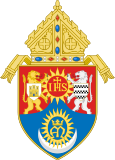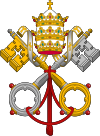Roman Catholic Archdiocese of Cebu
Archdiocese of Cebu Archidioecesis Nominis Iesu o Caebuana
| |
|---|---|
| Catholic | |
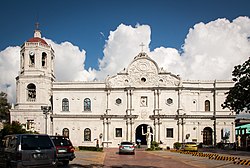 | |
 Coat of arms, 2022 design | |
| Location | |
| Country | |
| Territory | Cebu |
| Ecclesiastical province | Cebu |
| Metropolitan | Cebu |
| Coordinates | 10°17′45″N 123°54′11″E / 10.2958°N 123.9030°E |
| Statistics | |
| Area | 5,088 km2 (1,964 sq mi) |
| Population - Total - Catholics | (as of 2021) 5,310,651 4,621,792[1] (87%) |
| Parishes |
|
| Information | |
| Denomination | Catholic |
| Sui iuris church | Latin Church |
| Rite | Roman Rite |
| Established |
|
| Cathedral | Metropolitan Cathedral and Parish of St. Vitalis and of the Immaculate Conception |
| Patron saint | |
| Secular priests | 362 |
| Current leadership | |
| Pope | Francis |
| Metropolitan Archbishop | Jose Serofia Palma |
| Suffragans |
|
| Auxiliary Bishops |
|
| Vicar General | Vicente Rey Penagunda Rogelio Fuentes |
| Bishops emeritus | |
| Map | |
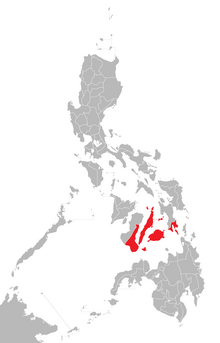 Jurisdiction of the metropolitan see within the Philippines. | |
| Website | |
| archdioceseofcebu | |
The Archdiocese of Cebu (more formally the Archdiocese of the Most Holy Name of Jesus in Cebu; Latin: Archidioecesis Nominis Iesu o Caebuana; Filipino: Arkidiyosesis ng Cebu; Cebuano: Arkidiyosesis sa Labing Balaan nga Ngalan ni Hesus sa Sugbo; Spanish: Arquidiocesis del Santisimo Nombre de Jesus de Cebu) is a Latin Church archdiocese of the Catholic Church in the Philippines and one of the ecclesiastical provinces of the Catholic Church in the country. It is composed of the entire civil province of Cebu (and the nearby islands of Mactan, Bantayan, and Camotes).[4][5][6][7][8] The jurisdiction, Cebu, is considered as the fount of Christianity in the Far East.[9]
The seat of the archdiocese is the Metropolitan Cathedral and Parish of St. Vitalis and of the Immaculate Conception, more commonly known as the Cebu Metropolitan Cathedral. The archdiocese honors Our Lady of Guadalupe de Cebú as its patroness, Vitalis of Milan as its patron and titular saint, and Pedro Calungsod (the second Filipino saint) as its secondary patron saint. The archbishop is José Serofia Palma, who was installed on January 13, 2011. As of 2013, the archdiocese registered a total of 4,609,590 baptized Catholics.[10]
Ecclesiastical province
[edit]The ecclesiastical province of Cebu comprises the metropolitan's own archbishopric and the following suffragan sees:
- Diocese of Dumaguete, in Negros Oriental (except Canlaon, Guihulngan, La Libertad, and Vallehermoso) and Siquijor
- Diocese of Maasin, in Southern Leyte
- Diocese of Tagbilaran, in southwestern Bohol
- Diocese of Talibon, in northeastern Bohol
History
[edit]Magellan's arrival and antecedents
[edit]The history of the future Archdiocese of Cebu began with the arrival of Ferdinand Magellan in Cebu in 1521.[11] The church anchored in that year[12] by the native Cebuanos' profession of faith in Christ,[13] baptism,[14] the daily celebration of the Mass,[15] and the chaplain of the expedition, Pedro Valderrama being the legitimate pastor for their spiritual needs.
In Cebu the first baptism was made (April 14, 1521); hence, Rajah Humabon and the rest of the natives became the very first Filipino Christians. In the island also was the first Mass in which Filipino converts participated. Also in the territory the first resistance against the Mohammedan advance from the south.[16] The first Philippine Christian feast dedicated to the Sto. Niño was instituted and celebrated there. The first recorded confession and the last rites of an accused inhabitant transpired.[17] The very first temples were erected (the Cebu Metropolitan Cathedral and Basilica del Santo Niño) in the Philippines.[18] The first Christian marriage transpired with Isabel, the niece of Rajah Tupas and Andres, the Greek caulker of Legazpi, and their children baptized representing the first infant baptisms.[19]
However, immediately after its inception during the aftermath of the Battle of Mactan, the Church of Cebu experienced decadence due to lack of shepherds to enforce and edify the natives on the faith. Most of the natives materially apostatized, while others clung unto the image of the Santo Niño (the first Christian icon in the Philippines given as a baptismal gift by Magellan). The unintended negligence lasted for 44 years until it was re-established in 1565 by the arrival of Miguel López de Legazpi and Fray Andrés de Urdaneta. The remnant of the Cebuano Church in 1521, as evident in the person of Rajah Tupas, was resuscitated by the Augustinians as an abbey nullius (an equivalent of a diocese)[20] when the formal evangelization of the Philippines commenced with Urdaneta as the first prelate.[21][22][23] The oversight of the natives was then succeeded to Fray Diego de Herrera who would later re-baptized Tupas and his servants in 1568. Adelantado Miguel Lopez de Legazpi established his government in Cebu, thus the first capital of the Philippines.
The church expanded from Cebu when the remaining missionaries led by Diego de Herrera were forced northwest temporarily due to conflict with the Portuguese and laid the foundations of the Christian community in Panay in around 1569.[4][7] In 1570, the second batch of missionaries reached Cebu. The island became the ecclesiastical "seat" as it was the center for evangelization. A notable missionary was Alfonso Jimenez, who travelled and penetrated the Camarines region through the islands of Masbate, Leyte, Samar, and Burias and founded the church there. He was called the first apostle of the region.[4][7]
By 1571, Herrera who was assigned as chaplain of Legazpi, from Panay advanced further north and founded the local church community in Manila. There, Legazpi transferred the seat of government though Cebu remained the spiritual capital of the country.[4][7] In 1572, the Spaniards led by Juan de Salcedo marched from Manila further north with the second batch of Augustinian missionaries and pioneered the evangelization to the communities in the Ilocos (starting with Vigan) and the Cagayan regions.[4][7]
Diocese of Cebu
[edit]On February 6, 1579, the Philippines' first diocese, the Diocese of Manila, was established as a suffragan of the See of Mexico. On August 14, 1595, Pope Clement VIII issued four bulls to Spain: one with the incipit Super universas orbis ecclesias[24][unreliable source] elevating the See of Manila to a metropolitan archdiocese; and three with the incipit Super specula militantis Ecclesiae[25][unreliable source] erecting the three suffragan dioceses of Manila, which were the Diocese of Cebu, the Diocese of Nueva Cáceres, and the Diocese of Nueva Segovia.[26] The Diocese of Cebu's first bishop was Pedro de Agurto, an Augustinian.[4][26] As a diocese, Cebú had a very extensive territory which then included the whole of the Visayas, Mindanao[11] and "more southern islands";[27] also it extended farther to the Pacific such as the Marianas,[28] Carolines, and Palau.[29]
However, it lost territory repeatedly:
- on May 27, 1865, to establish then Diocese of (Santa Isabel de) Jaro (now an Archdiocese)
- on September 17, 1902, to establish Apostolic Prefecture of Mariana Islands
- on April 10, 1910, to establish Diocese of Zamboanga and Diocese of Calbayog
- on July 15, 1932, to establish Diocese of Bacolod
Archdiocese of Cebu
[edit]On April 28, 1934, Pope Pius XI promulgated an apostolic constitution with the incipit Romanorum Pontificum semper separating the dioceses of Cebu, Calbayog, Jaro, Bacolod, Zamboanga and Cagayan de Oro from the ecclesiastical province of Manila. The same constitution elevated the diocese into an archdiocese while placing all the newly separated dioceses under a new ecclesiastical province with Cebu as the new metropolitan see.[30] The last suffragan bishop, Gabriel M. Reyes, was promoted as its first archbishop.
On November 8, 1941, it lost territory to establish Diocese of Tagbilaran as its suffragan.
Cebu was visited by Pope John Paul II in February 1981. In his Homily for Families (February 19, 1981), the supreme pontiff called the island as the birthplace of the faith:
Finding myself in this important city known as the cradle of Christianity in the Philippines, I want to express my deep joy and profound thanksgiving to the Lord of history. The thought that for 450 years the light of the Gospel has shone with undimmed brightness in this land and on its people is cause for great rejoicing.[31]
Between November 10, 1985, and March 1, 1986, the archdiocese held its Fourth Diocesan Synod of Cebu at the Seminaryo Mayor de San Carlos.
It hosted the 51st International Eucharistic Congress from January 24 to 31, 2016.
Sugbuswak: Division to three dioceses
[edit]Plans to divide the Archdiocese of Cebu was first laid during the pastoral leadership of Cardinal Julio Rosales.[32] It was raised again on August 20, 2002, during the pastoral leadership of then-Archbishop Cardinal Ricardo Vidal.[33]
The plan was revived again on December 31, 2022, when Archbishop Jose S. Palma announced a feasibility study on the planned division of the archdiocese.[34] The archdiocese coined the term "Sugbuswak", derived from "Cebu" and the Cebuano word "buswak", referring to the flowering or blossoming of new dioceses.[9] The plan calls for the erection of two new suffragan dioceses in Danao, which would cover the northern part of the civil province of Cebu; and in Carcar, covering the southern part of the province. The territory of the metropolitan archdiocese would be reduced to the central part of the province, including Cebu City and its neighboring towns, as well as the island of Mactan.[33] The plan aims for better pastoral management in churches.[32]
During its 126th Plenary Assembly in Kalibo, Aklan in July 2023, the Catholic Bishops' Conference of the Philippines (CBCP) unanimously approved the planned division of the Archdiocese of Cebu. It also received support from the Cebuano people.[35] Archbishop Palma presented the proposal to the Holy See on March 11, 2024, as part of his ad limina visit to Pope Francis.[36]
In December 2024, Archbishop José S. Palma suspended indefinitely the celebration of Traditonal Tridentine Mass (TLM) until further notice.[37]
Coat of arms
[edit]
The ecclesiastical arms of the Archdiocese of Cebu was redesigned by a professional Italian heraldic artist, Sig. Marco Foppoli, as commissioned by the priests-secretaries of the Office of the Archbishop in the first quarter of 2021, with the facilitation and benefaction of Msgr. Jan Thomas V. Limchua.
The re-designed coat of arms of the archdiocese consists of a simple yet traditional shield, which is the most commonly used form in ecclesiastical heraldry. In a chapé ("mantled") ployé partition, which is formed by two arched lines drawn from the center chief to the sides, the shield itself is divided into two fields: the upper field, in red (gules); and the lower field, in blue (azure).
The upper field of red represents the Niño de Cebu (Bato Balani sa Gugma, or Magnet of Love), whose very image, which at first was a gift during the first baptism five hundred years ago, has now become the symbol of the Catohlic faith in Cebu.
On this same field are two lions: the first lion, in gold, is emblazoned with the coat of arms of the Kingdom of Castile; while the other, in silver, is emblazoned with the personal coat of arms of Ferdinand Magellan—these two elements were present in the original coat of arms granted to the archdiocese. Both refer to the Hispanic origin and nascent beginning of Catholicism in Cebu, the cradle of Christianity in the Philippines.
These two lions support the stylized monogram of the Holy Name of Jesus inside a stylized image of the sun—symbolizing Christ as the light of the world. It is deliberately placed at the top center of the arm, representing the titular of the archdiocese. It also recalls the life and ministry of Jesus in the words of Paul (Letter to the Philippians): "…he humbled himself, becoming obedient to death, even death on a cross. Because of this, God greatly exalted him and bestowed on him the name that

is above every name, that at the name of Jesus every knee should bend, of those in heaven and on earth and under the earth, and every tongue confess that Jesus Christ is Lord, to the glory of God the Father." (Phil. 2:7–11)
The field of red also honors the Visayan Proto-Martyr, Pedro Calungsod.
The lower field of blue symbolizes Our Lady and her motherly mantle of love and compassion for the Cebuano faithful as also portrayed by the monogram "Auspice Maria" (Under the Protection of Mary) with a gold crown (above), a silver crescent (below), and gold gloriole (around the monogram). This imagery specifically refers to her image and title, Our Lady of Guadalupe de Cebu, through whose intercession, and by God's grace flowing from above, has saved Cebu from the cholera epidemic of 1902. On 16 July 2006, Virgen de Guadalupe de Cebu was canonically crowned by the authority of Pope Benedict XVI as patroness of the archdiocese.
The upward, arrow tip-like shape of the blue field can be understood as a reminder to the Cebuano faithful that a deep devotion to the Virgin Mary inevitably leads to a greater love for her Divine Son, Our Lord. This is reminiscent of the traditional aphorism, "Ad Jesum per Mariam" (to Jesus, through Mary).
The entire shield is surmounted by the conventional heraldic elements identifying it to be the coat of arms of an archdiocese, namely a miter, and the crossed crozier and archiepiscopal cross.
Written on a scroll, below the arms, is the Motto of the Archdiocese: "Sanctum Nomen Eius," which means "Holy is His Name," taken from Mary's Magnificat (Luke 1:49).[38]
Ordinaries
[edit]Prelates of Cebu
[edit]- Andrés de Urdaneta (April 1565 – June 1565), considered as first prelate of the Philippines.[39][40]
- Diego de Herrera (June 1565 – 1569)
- Martín de Rada (1569–1572)
- Alfonso Jimenez (1575–1577)[41]
Suffragan bishops of Cebu
[edit]- Pedro de Agurto (30 August 1595 Appointed – 14 Oct 1608 Died)
- Pedro de Arce (17 Sep 1612 Appointed – 16 Oct 1645 Died)
- Juan Velez (26 Jan 1660 bishop elect – 1662 Died)
- Juan López † (23 April 1663 Appointed – 14 Nov 1672), later Metropolitan Archbishop of Manila (Philippines) (1672.11.14 – death 1674.02.12)
- Diego de Aguilar (16 Nov 1676 Appointed – 1 Oct 1692 Died)
- Miguel Bayot (13 May 1697 Appointed – 28 Aug 1700 Died)
- Pedro Sanz de la Vega y Landaverde (26 Jan 1705 Appointed – 17 Dec 1717 Died)
- Apostolic Administrator Sebastián Foronda (2 March 1722 Appointed – 20 May 1728 Died)
- Manuel de Ocio y Campo (20 Jan 1734 Appointed – 21 July 1737 Died)
- Protacio Cabezas (29 Aug 1740 Appointed – 3 Feb 1753 Died)
- Miguel Lino de Ezpeleta (18 July 1757 Appointed – 1771 Died)
- Mateo Joaquin Rubio de Arevalo (13 Nov 1775 Appointed – 1788 Died)
- Ignacio de Salamanca (24 Sep 1792 Appointed – Feb 1802 Died)
- Joaquín Encabo de la Virgen de Sopetrán (20 Aug 1804 Appointed – 8 Nov 1818 Died)
- Francisco Genovés (21 March 1825 Appointed – 1 Aug 1827 Died)
- Santos Gómez Marañón (28 Sep 1829 Appointed – 23 Oct 1840 Died)
- Romualdo Jimeno Ballesteros (19 Jan 1846 Appointed – 17 March 1872 Died); previously Titular Bishop of Ruspæ (1839.08.02 – 1846.01.19) & Coadjutor Apostolic Vicar of Eastern Tonking (Vietnam) (1839.08.02 – 1845.06.20), Coadjutor Bishop of Manila (Philippines) (1845.06.20 – 1846.01.19)
- Benito Romero (28 Jan 1876 Appointed – 4 Nov 1885 Died)
- Martín García y Alcocer (7 June 1886 Appointed – 30 July 1904 Resigned); emeritate as Titular Archbishop of Bostra (1904.07.30 – 1926.05.20)
- Thomas A. Hendrick (17 July 1903 Appointed – 29 Nov 1909 Died)
- Juan Bautista Gorordo (2 April 1910 Appointed – 19 June 1931 Resigned), succeeded ad former Titular Bishop of Nilopolis (1909.04.29 – 1910.04.02) & Auxiliary Bishop of Cebu (1909.04.29 – 1910.04.02); emeritate as Titular Bishop of Tacapæ (1931.06.19 – 1934.12.20)
- Gabriel M. Reyes (29 July 1932 Appointed – 1934.04.28 see below)
Metropolitan archbishops of Cebu
[edit]| Bishop | Period in office | Coat of arms | Notes | ||
|---|---|---|---|---|---|
| 1. | Gabriel M. Reyes | April 28, 1934 – August 25, 1949 (15 years, 119 days) |
 |
Appointed Coadjutor Archbishop of Manila & Titular Archbishop of Phulli | |
| 2. | 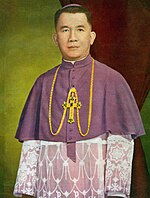 |
Cardinal Julio Rosales y Ras | December 17, 1949 – August 24, 1982 (32 years, 250 days) |
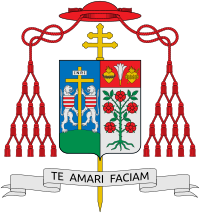 |
Created Cardinal by Pope Paul VI on April 28, 1969 |
| 3. | 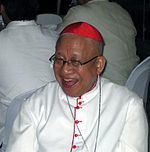 |
Cardinal Ricardo Vidal | August 24, 1982 – October 15, 2010 (28 years, 52 days) |
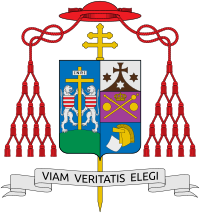 |
Created Cardinal by Pope John Paul II on May 25, 1985 |
| 4. |  |
Jose S. Palma | January 13, 2011–present (14 years, 87 days) |
 |
|
Auxiliary bishops
[edit]| Bishop | Period in office | Titular see | Coat of arms | Notes | ||
|---|---|---|---|---|---|---|
| 1. | Juan Durán | 1680 -1681 | Zenopolis in Lycia | |||
| 2. | Juan Bautista Gorordo y Perfecto | 1909–1910 | Nilopolis | Succeeded as Bishop of Cebu | ||
| 3. | Manuel Sandalo Salvador | 1960–1969 | Nasbinca Zarna (As Titular Archbishop) |
 |
||
| 4. | Nicolas Mollenedo Mondejar | 1970–1974 | Grumentum | Appointed Bishop of Romblon | ||
| 5. | Jesus Armamento Dosado | 1977–1979 | Nabala | Appointed Auxiliary Bishop of Cagayan de Oro, later Archbishop of Ozamis | ||
| 6. | Angel Nacorda Lagdameo | 1980–1986 | Oreto |  |
Appointed Bishop of Dumaguete | |
| 7. | Camilo Diaz Gregorio | 1987–1989 | Girus | Appointed Bishop of Bacolod | ||
| 8. | Leopoldo Sumaylo Tumulak | 1987–1992 | Lesvi | Appointed Bishop of Tagbilaran | ||
| 9. | Emilio Layon Bataclan | 1990–1995; 2004–2015 | Gunela (1900–1995) Septimunicia (2004–2015) |
 |
Appointed Bishop of Iligan, Reappointed as Auxiliary Bishop of Cebu | |
| 10. | Antonio Racelis Rañola | 1990–2003 | Claternae |  |
||
| 11. | Jose Serofia Palma | 1997–1999 | Vazari-Didda | Appointed Bishop of Calbayog, later Archbishop of Cebu | ||
| 12. | Precioso Dacalos Cantillas | 1995–1998 | Vicus Caesaris |  |
Appointed Bishop of Maasin | |
| 13. | John Forrosuelo Du | 1997–2001 | Timici |  |
Appointed Bishop of Dumaguete; later Archbishop of Palo | |
| 14. | Antonieto Dumagan Cabajog | 1999–2001 | Reperi |  |
Appointed Bishop of Surigao | |
| 15. | Julito Buhisan Cortes | 2001–2013 | Severiana |  |
Appointed Bishop of Dumaguete | |
| 16. | Isabelo Caiban Abarquez | 2002–2004 | Talaptula |  |
Appointed Bishop of Calbayog | |
| 17. | Oscar Jaime Llaneta Florencio | 2015–2019 | Lestrona |  |
Appointed Bishop of the Military Ordinariate of the Philippines | |
| 18. | Dennis Cabanada Villarojo | 2015–2019 | Gisipa |  |
Appointed Bishop of Malolos | |
| 19. | Midyphil Bermejo Billones | 2019–present | Tagarata |  |
||
| 20. | Ruben Caballero Labajo | 2022–present | Abbir Maius |  |
Appointed as the first Bishop of the Diocese of Prosperidad[42] | |

Diocesan Seminaries
[edit]- Pope John XXIII Seminary', Pope John Paul II Avenue, Barangay Luz, Cebu City
Rector: Allan Delima
- San Carlos Seminary College, Pope John Paul II Avenue, Barangay Luz, Cebu City
Rector: Joseph Tan
- Seminario Mayor de San Carlos, Pope John Paul II Avenue, Barangay Luz, Cebu City
Rector: Mhar Balili
- Spiritual Pastoral Formation Year House, Archbishop's Residence Compound, D. Jakosalem St., Cebu City
Director: Alvin Raypan
Archdiocesan Calendar
[edit]The Calendar of the Archdiocese of Cebu is based on the General Roman Calendar and the Philippine Standard Calendar. Below are the following additions and changes to the calendar.
- 3 January – Most Holy Name of Jesus, titular of the archdiocese – Solemnity
- Third Sunday of January (2025 date: 19 January) – Santo Niño de Cebú – Solemnity
- 28 January – Dedication of the Cebu Metropolitan Cathedral as an Archdiocesan cathedral – Feast (Solemnity in the cathedral itself)
- 29 January – Saint Thomas Aquinas, priest and doctor of the Church – Memorial
- 11 February – Our Lady, Health of the Sick – Optional Memorial
- 1 April – Saint Pedro Calungsod, Cebuano martyr and secondary patron of the archdiocese- Feast
- 28 April – Saint Vitalis of Milan, martyr and titular of the metropolitan cathedral – Memorial (Solemnity in the Cathedral itself)
- 15 May – Saint Isidore the Laborer – Memorial
- 30 May – Saint Ferdinand III of Castile, king – Optional Memorial
- 2 August – Our Lady of the Angels of Portiuncula – Optional Memorial
- 16 August – Saint Roch – Memorial
- 19 August – Saint Ezechiel Moreno, bishop – Memorial
- 22 August – Our Lady, Queen of the Visayas, principal patroness of the Visayas Region – Feast
- 10 September – Saint Nicholas of Tolentino, priest – Optional Memorial
- 22 September – Saint Thomas of Villanova (Sto. Tomas de Villanueva), bishop – Memorial
- 24 September – Saints Cosmas and Damian, martyrs or Saint Wenceslaus, king martyrs- Optional Memorial
- 25 September – Saint Vincent de Paul, priest – Memorial
- 26 September – Saint Paul VI, pope (Elevated the Santo Niño Church into a minor basilica status) – Memorial (Feast in the basilica itself)
- 27 September – Commemoration of the Servant of God Teofilo Camomot, Cebu's former auxiliary bishop
- 28 September – Saint Lorenzo Ruiz and Companions, martyrs – Memorial
- 18 November – Dedication of the Cebu Metropolitan Cathedral as a diocesan cathedral – Feast (Solemnity in the cathedral itself)
- 12 December – Our Lady of Guadalupe, principal patroness of the archdiocese – Solemnity
See also
[edit]- Catholic Church in the Philippines
- Archdiocese of Manila
- Archdiocese of Caceres
- Diocese of Talibon
- List of the Catholic dioceses of the Philippines
- Cebu Catholic Television Network
References
[edit]- ^ "Cebu (Catholic Metropolitan Archdiocese)". gcatholic.org. Retrieved September 15, 2023.
- ^ "Most Rev. Antonia R. Rañola, D.D." Catholic Bishops' Conference of the Philippines. Retrieved November 6, 2022.
- ^ "Rinunce e nomine" [Resignations and Appointments] (Press release) (in Italian). Holy See Press Office. October 1, 2015. B0746. Retrieved November 6, 2022.
- ^ a b c d e f Pangan, J.K. (September 16, 2014). "Cebu—Cradle of the Philippine Church and Seat of Far-East Christianity" (PDF). International Eucharistic Congress 2016. Retrieved December 4, 2014.
- ^ "CATHOLIC ENCYCLOPEDIA: Cebu".
- ^ The Church of Cebu's Basilica del Santo Niño is named by the Vatican as "mother and head of all churches in the Philippines" (mater et caput... omnium ecclesiarum Insularum Philippinarum). See https://www.vatican.va/content/paul-vi/la/apost_letters/documents/hf_p-vi_apl_19650401_ut-clarificetur.html.
- ^ a b c d e John Kingsley Pangan, Church of the Far East (Makati: St. Pauls, 2016),
- ^ "Cebu & Philippines". July 2014.
- ^ a b Mayol, Ador Vincent (January 25, 2023). "Cebu archdiocese, biggest in PH, to be split into 3". Philippine Daily Inquirer. Retrieved February 24, 2024.
- ^ "Cebu (Archdiocese)". Catholic-Hierarchy.org. David M. Cheney. March 17, 2023.
- ^ a b "History : The Official Website of Cebu Archdiocese". Archived from the original on August 13, 2010. Retrieved July 18, 2010.
- ^ Carmelo D. F. Morelos, "'Go… Make Disciples!' – A Pastoral Letter on the Fourth Centenary of the Archdioceses of Manila, Cebu, Cáceres, Nueva Segovia," Catholic Bishops Conference of the Philippines, January 29, 1994, accessed September 6, 2014, http://cbcponline.net/v2/?p=8078
- ^ Antonio Pigafetta, Magellan's Voyage Around the World, vol. 1, trans. James Alexander Robertson (Cleveland: The Arthur H. Clark Company, 1906), 159.
- ^ Antonio Pigafetta, Magellan's Voyage Around the World, vol. 1, trans. James Alexander Robertson (Cleveland: The Arthur H. Clark Company, 1906), 151–155.
- ^ Antonio Pigafetta, Magellan's Voyage Around the World, vol. 1, trans. James Alexander Robertson (Cleveland: The Arthur H. Clark Company, 1906), 157.
- ^ Juan de Medina, OSA, "Historia de la Orden de San Agustin de estas Islas Filipinas," in The Philippine Islands 1493–1803, vol. 23, eds. Emma H. Blair, James A. Robertson (Cleveland: The Arthur H. Clark Company, 1903), 185.
- ^ Résumé of Documents, 153.
- ^ Astrid Sala-Boza, "The Contested Site of the Finding of the Holy Child: Villa San Miguel or San Nicolas (Cebu El Viejo)," Philippine Quarterly of Culture Society 34, (2006): 232. www.jstor.org/stable/29792595; The Philippine Islands, 1493–1803, vol. 2, eds. Emma Helen Blair, James Alexander Robertson (Cleveland: The Arthur H. Clark Company, 1903), 121.
- ^ Résumé of Documents, 140–141.
- ^ gcatholic.org
- ^ The Philippine Islands, 1493–1803, vol. 2, eds. Emma Helen Blair, James Alexander Robertson (Cleveland: The Arthur H. Clark Company, 1903), 33, note 5.
- ^ Blair, Emma Helen; Robertson, James Alexander, eds. (1903). The Philippine Islands, 1493–1803 vol. 2. Cleveland: The Arthur H. Clark Company. p. 168.
- ^ Bartholomé de Letona, OSF, The Philippine Islands, 1493–1803, vol. 36, eds. Emma Helen Blair, James Alexander Robertson (Cleveland: The Arthur H. Clark Company, 1906), 210.
- ^ Siniculus. "Dei praesidio fultus: Philippine Bullary I".
- ^ Siniculus. "Dei praesidio fultus: Philippine Bullary II".
- ^ a b Philippine Star: "Fray Pedro de Agurto, OSA: The first Bishop of Cebu" By Fr. Ric Anthony Reyes, OSA (The Freeman) October 12, 2014
- ^ The Philippine Islands, 1493–1898 — Volume 12 of 55 Summary.
- ^ "Archdiocese of Cebu, Philippines".
- ^ Felipe Redondo y Sendino, Breve reseña de lo que fue y de lo que es la Diócesis de Cebú en las Islas Filipinas, trans. Azucena L. Pace (Cebu City: University of San Carlos Press, 2014), Breve Reseña, 74.
- ^ Pope Pius XI, Apostolic Constitution separating some dioceses from the ecclesiastical province of Manila to form the new ecclesiastical province of Cebu Romanorum Pontificum semper (April 28, 1934), Acta Apostolicae Sedis 27 (1935), pp.263–264. PROVINCIA ECCLESIASTICA MANILANA DISMEMBRATIO ET NOVA CAEBUANA PROVINCIA ERIGITUR.
- ^ "19 February 1981: Mass for families, Cebu City, Philippines | John Paul II".
- ^ a b Limpag, Max (September 26, 2023). "Don't rush breakup of Archdiocese of Cebu, some Cebu priests say". MyCebu.ph. Retrieved February 24, 2024.
- ^ a b Limpag, Max (November 21, 2023). "Cebu clergy, lay finalize proposal to break up Archdiocese of Cebu". MyCebu.ph. Retrieved February 24, 2024.
- ^ "'Sugbuswak' talks continue on new Cebu diocese in Danao City". GMA Regional TV. January 3, 2024. Retrieved February 24, 2024.
- ^ Saavedra, John Rey (February 14, 2024). "Cebuanos support Archdiocese's split". Philippine News Agency. Retrieved February 24, 2024.
- ^ "Pope Seen to greenlight a proposal to create two new Cebu dioceses, says Archbishop Palma". Radio Veritas Asia. February 19, 2024. Retrieved February 24, 2024.
- ^ Limpag, Max (December 4, 2024). "Cebu Archbishop Palma suspends Traditional Latin Mass". Rappler. Retrieved December 8, 2024.
- ^ "The Roman Catholic Archdiocese of Cebu updated their profile picture". The Roman Catholic Archdiocese of Cebu. Retrieved November 6, 2022 – via Facebook.
- ^ Bartolomé de Letona, OSF (1662), "Description of the Filipinas Islands" in The Philippine Islands, 1493–1803, vol. 34, eds. Emma H. Blair and James A. Robertson (Cleveland: The Arthur H. Clark Company, 1906), 208. "The Order of St. Augustine entered the islands in the year [1]565; its first superior, and first prelate of all the islands was Fray Andres de Urdaneta – a Vascongado,40 and a son of the convent and province of Mexico; he was the apostle who unfurled the gospel banner, and he planted the faith in the island of Zebu' and others."
- ^ Bibliography on Legazpi and Urdaneta, Isacio R. Rodriguez, Philippine Studies: Historical and Ethnographic Viewpoints(Ateneo de Manila University:1965).
- ^ The Philippine Islands 1493–1803, vol. 23, eds. Emma H. Blair, James A. Robertson (Cleveland: The Arthur H. Clark Company, 1903), 209. "In April of the year 1565, there was founded in Zebu (afterward being transferred to Manila) the church and ecclesiastical community of these islands; and its ordinary jurisdiction was allotted to the superiors of the Order of St. Augustine, who were the founders and apostles of this kingdom; they held that dignity up to the year of [15]77".
- ^ "Pope creates new Philippine diocese, names its first bishop". CBCP News. October 15, 2024. Retrieved October 15, 2024.
Notes
[edit]- ^ The religious superiors, in this case the Augustinians in Cebu, functioned as ordinaries in mission territories with no diocese through the papal bull Omnimodam auctoritatem nostram made by Pope Adrian VI. Thus, consequently making the first Augustinian superiors as Prelates of Cebu. Their prelacy are more historical than canonical. The modern equivalent of this is a Territorial Superior. See more in gcatholic.org.

